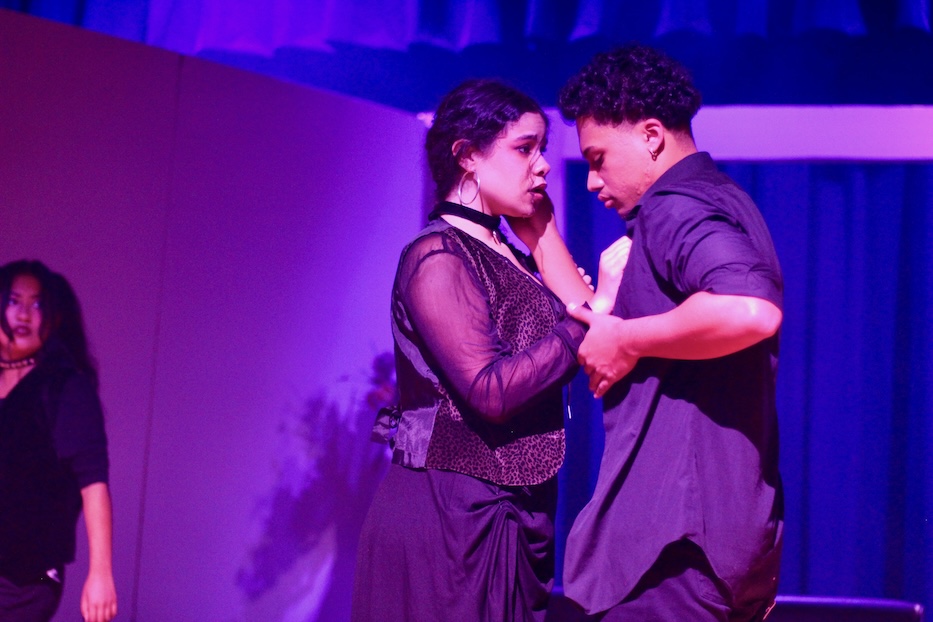
Culture & Community | Education & Youth | Elm Shakespeare Company | Arts & Culture | Theater | New Haven Academy
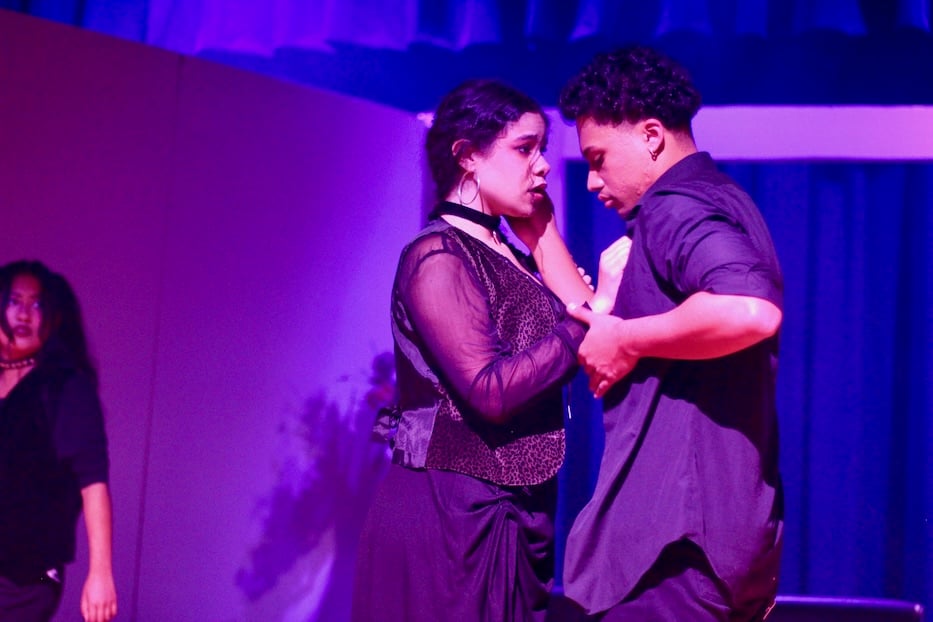
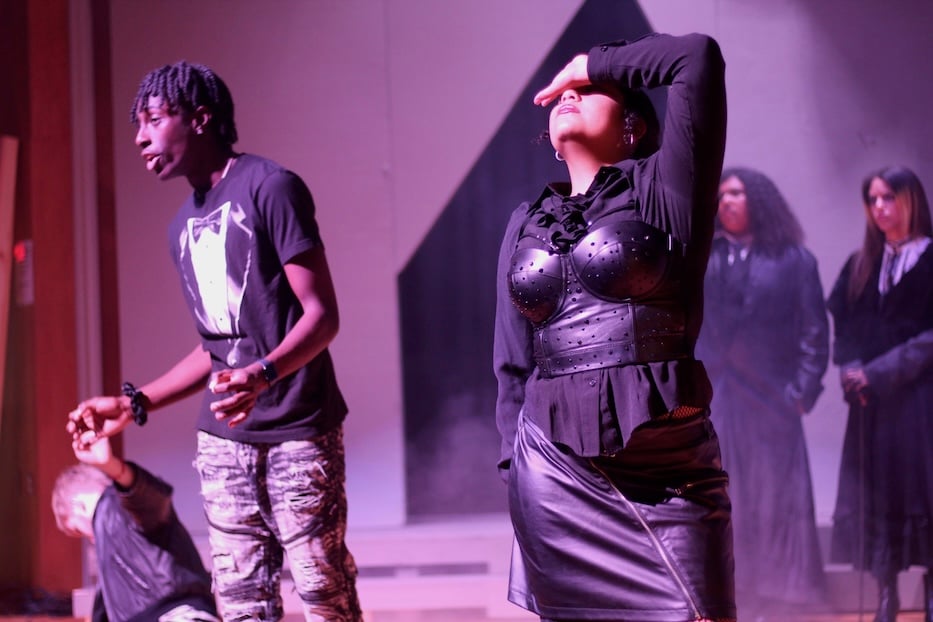
Top: Tomitsela Engel-Halfkenny as Ophelia and Cristian Ortiz as one of four Hamlets. Bottom: Solimar Quintanilla as the Player Queen. Lucy Gellman Photos.
Night, somewhere in the bowels of Elsinore. Beneath sheaves of blue and purple light, a heartbeat murmured, steady and drum-like. It rolled through the space, transforming a high school gym into the Danish countryside. On stage, Hamlet’s voice—his voices—cut through the darkness, splitting into threads and then coming back together again.
“Now I am alone,” four voices called out, woven together, crisp and heavy. Breath drifted over the stage. “O, what a rogue and peasant slave am I!” Something was rotten in Denmark, and New Haven was infinitely better for it.
The play is definitely the thing this week, as New Haven Academy returns to the stage with a pop-punk, 90-minute adaptation of Hamlet that is more open, accessible, and biting than its three-hour source text. Spliced to feature four Hamlets instead of one, the work is judiciously edited and mined for feeling, with all the emotional heft of its language intact.
The show is a collaboration between Legacy Studios, the high school’s popular after-school drama club, and Elm Shakespeare Company, which has been able to grow its educational footprint thanks to a grant from the Seedlings Foundation. It is directed by Elm’s Liz Daingerfield and “drama poppa” Ty Scurry, who first worked together on A Midsummer Night’s Dream last year.
Performances run Nov. 6 through 9 at New Haven Academy; tickets and more information are available here.
“I’m excited. From what we’ve watched in rehearsal, the kids are ready. They’re killing it,” Scurry said at a tech rehearsal Monday night, as cast members took their places in the gym-turned-theater. Now a retention specialist at High School in the Community, he’s watched it come together in just six weeks. “Each Hamlet is one part of his emotion. It’s meant to make you ask, ‘Is he actually losing it or is he just trying to deal with his grief?’”
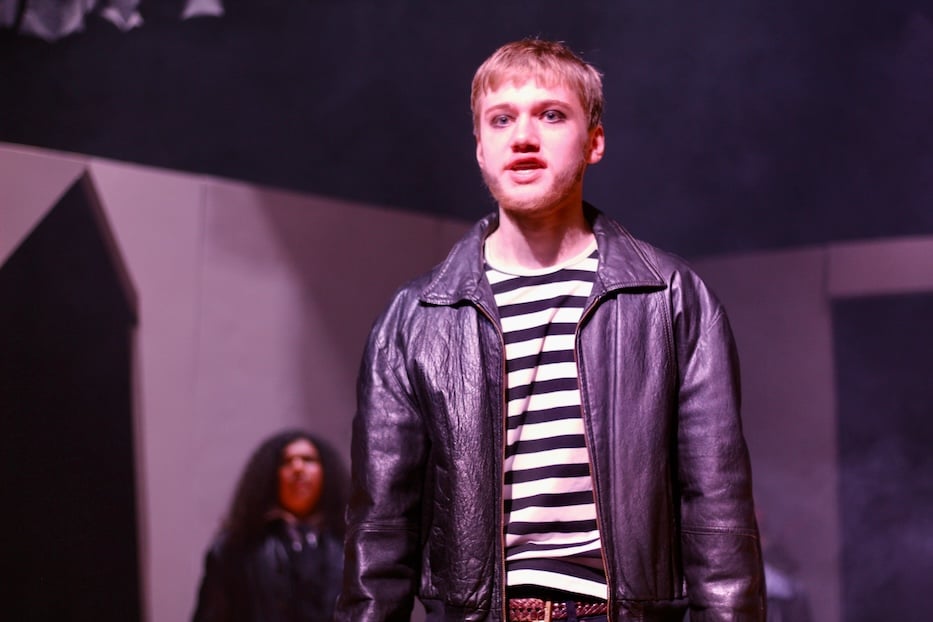

Top: Elm’s Liz Daingerfield and “drama poppa” Ty Scurry. Bottom: Oliver Reymond as the Player King.
That starts and ends, of course, with the text itself. Written on the lip of the seventeenth century, Hamlet tells the story of the Prince of Denmark (freshman Molly Davis, seniors Cristian Ortiz and Christopher Samuels, and sophomore Olivia Tapia Ko), who is driven insane by his deep and gnawing grief at his father’s death. Visited by the ghost of the Old King (a winning Semaj Battle-Reed, a junior who has very much come into his own), Hamlet learns that his father was murdered by his Uncle Claudius (Joseph Pallo), who is now married to his mother (Michelle Cochran as Queen Gertrude of Denmark).
If you're still following, congratulations. It's about to go down.
Hamlet, furious at his uncle, flies into murderous rage from which no one and nothing is safe. Guards (Jermaine Cowan and Andy Sosa as Marcellus and Bernardo) and grave diggers (Oliver Reymond, Solimar Quintanilla and Austen Fay, who also stage manages the show) get spooked by the specter of the old king, whose soul is not yet free. Hamlet’s wronged woman (Tomitsela Engel-Halfkenny as Ophelia), befuddled and bereft at their situationship, ends her life surrounded by flowers, a scene to which painters and poets would return for the next 400 years. Actors perform a play within a play, setting the final devastating acts in motion. It’s all a potent reminder of the ways grief and trauma can ripple out until they have poisoned the whole ocean.
When she was thinking about the project, Daingerfield read something in the words that reminded her of a very different moment in time: the pop-punk-emo wave of bands, mostly angsty boys with long, limp, poorly dyed hair and permanently sulking expressions, that captivated the U.S. music scene in the early 2000s, when she was coming into her own as a high school student.
At the time, “music was my escape” from the monotony of high school, with bands like Panic at the Disco, Coheed and Cambria, The Used, Taking Back Sunday and Something Corporate that got her through. Daingerfield would sit in her car and sing along, the music unlocking something within her. At a recent tech rehearsal, she laughed remembering attending the bands’ concerts with her sister, and getting an array of belts signed.
The only other place she felt a release like that, she realized years later, was when she was performing Shakespeare. And who, amongst all of the Bard’s tragic heroes, was angstier and more brooding than Hamlet?
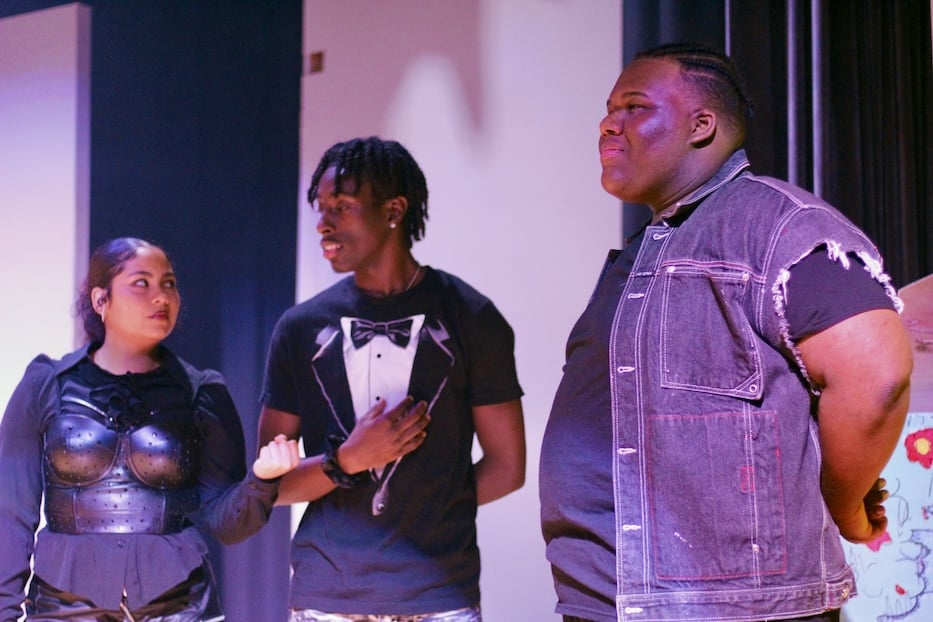
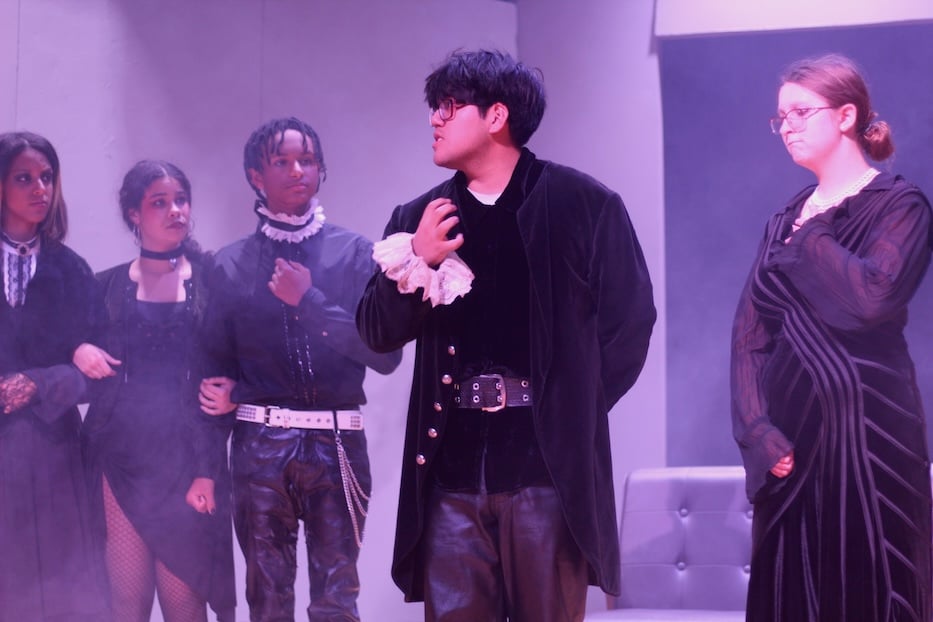
Pallo as a murderous and plotting Claudius.
“I think there’s a connection between the heightened language [in Shakespeare] and the music,” Daingerfield said. “The Broadway version, when we get $8 million, would have a live band onstage,” à la the musical SIX. For now, she’s excited to see her and Scurry’s vision come to fruition with well-placed, spiky chokers, enamel pins, grunge boots, and plenty of ruffled white collars and see through mesh tops. That, and the Hamlets themselves, who harness their four separate voices to present a single, richly layered and pained portrait of a man.
As it comes to New Haven Academy, the adaptation works several times over, even on the program’s shoestring budget. As fuzz-kissed music plays in act one, fog hangs over the stage, a chalky cloud through which light radiates in low beams. Through the dust, Battle-Reed sweeps in, laying his body on a couch at the center of the stage. He reclines, and even without words strikes a balance between sleeping and fitful, as if he is already aware of the heavy pendulum he is about to put into motion.
The young actor, who first found the Bard in middle school, lends sass and strength to the role that is refreshing, like you know he could read someone for filth while also making them wet their pants from fear. When he bellows “Mark Meeeeee,” somehow at once a whisper and a roar, he lands it. When he half-growls “Murder most foul!” a listener can feel it in their chest. Around him, and in the audience, it makes the meaning immediately more accessible, as if instead of “So art thou to revenge when thou shalt hear,” he’s just saying “You’re gonna get him, right?”
If there is murder here, there is also magic. Summoned in their grief, the four Hamlets create a heartbeat (sometimes literally, thanks to sound designer Keirsten Gentles), showing in real time the way that big feelings can split a person into multiple versions of themselves.
Samuels, who has come a long way since his debut in Paradise Blue, has a way of rolling his eyes back into his head, as if this Hamlet is already half-gone. Tapia Ko, who looks ready for a Coheed and Cambria concert, nearly spits her lines, in a way that harnesses the prince’s red-hot anger more than his anguish. She’s mad, and cuts through 400 years of language to make clear that she’s going to do something about it.


Molly Davis (top) and Olivia Tapia Ko (bottom) as two of four Hamlets.
“I feel like because I’m playing a quarter of a lead role, it’s a little bit funny and something that I’ll never have the chance to do again,” she said before tech rehearsal Monday. “I think it’s really interesting that I got to work with three other actors on the same role, to get to develop the same character but different versions of it. The whole point of our very emo, very meta Hamlet is that different parts of him require their time in different scenes.”
Ortiz, who is a senior this year, glides into his roles with a kind of presence that he brought to a very different role in Once On This Island last year. Davis, who is only a freshman, steals whole scenes with a wine-colored mouth and permanent scowl on her face, especially compelling when she and Cochran share a scene. She, more than any other Hamlet, is physically repulsed by this version of Gertrude, and makes no attempt to hide her disdain. The result, paired with a keen sense of language and timing, is a real understanding of Hamlet’s pain, and the deeply uncomfortable and disquieting position his mother has put him in.
Around these ghosts and princes, characters spring to life, and no one misses. As a sumptuous dressed Polonia, advisor to Claudius (changed from Polonius, although the swap is not particularly meaningful here), senior Emely Lebron leans into the role, finding the hard, sometimes clownish edge of the character that cares more about power and influence than her own children, Ophelia and Laertes (a winning Joaquin Tobin, who is most dynamic when sharing scenes with, or throwing down for, Engel-Halfkenny).
As Claudius, Pallo does his best to channel a villain capable of cold-blooded murder, and shows how a character drunk on a fantasy of being king can make careless missteps in the process. As Hamlet’s truest friend, senior Jaileen Sowell is a strong Horatio, digging deep into the role as she rocks a white blazer, chains, dog tags and sparkly platform shoes that give the character a kind of glam upgrade. Even Gabriella Osborn and Cameron Silva, cast as Rosencrantz and Guildenstern, find the balance between ostensible friendship—are they people in whom Hamlet can truly confide?—and the ways that power and order manipulates.
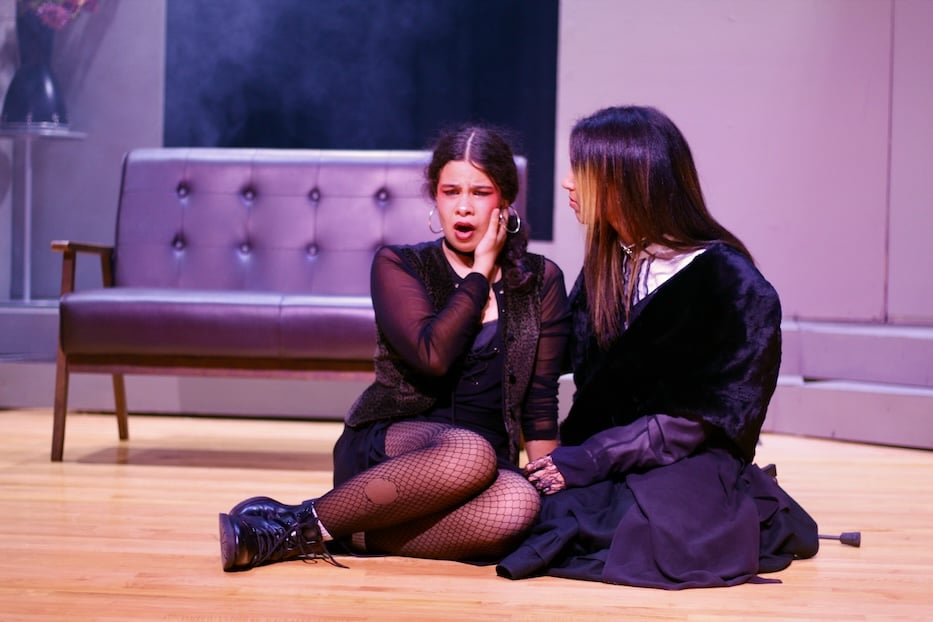

Top: Tomitsela Engel-Halfkenny and Emely Lebron. Bottom: Senior Jaileen Sowell as Horatio.
The play belongs, however, to both Hamlet and a punk, moody Ophelia, with her vampy black lipstick and thick-soled Doc Martin boots. In the role, Engel-Halfkenny owns the stage, rejecting centuries-long tropes of Ophelia as the OG manic pixie dream girl (although there are some memorable temper tantrums). Instead, she opts for something punchier, clear-eyed about the havoc that Hamlet and his family have wrought in her own life.
When, with Polonia, she recounts Hamlet’s abusive behavior—a feat of blocking, in which she bounces between all four Hamlets—there’s a sparkle of recognition there, that she as a teenage girl should not have to put up with this level of nonsense from a boy who could really use some therapy. When Polonia brushes it off, it makes it all the more enraging. As Engel-Halfkenny too descends into madness, she makes clear the stakes of her own life and death, in a way that stays with a viewer long after the show.
“Ophelia just needs to be left alone, and she never gets that,” Engel-Halfkenny said. “She never gets to be left alone. Even after I die, I still don’t get left alone! There’s never a moment where Ophelia actually gets to rest. Being a woman, society doesn’t allow you to rest.”
Beyond the actors, set, costume, blocking and production do the rest of the work. Handheld lanterns, strobes, and low, spectral lighting bend time and space, jumping between past and present. A series of quiet directing choices, including moody red lighting to depict murder, and a decision to bring Ophelia back onstage after her suicide, pack an emotional punch. A minimalist set from designer April Chateauneuf ties it all together, enough to lend the show a sense of place while making clear that the focus should be on the actors. Costume design from Solimar Quintanilla, who is also in the show, and whiney pop-punk interludes that take it back to the oughts do the rest.

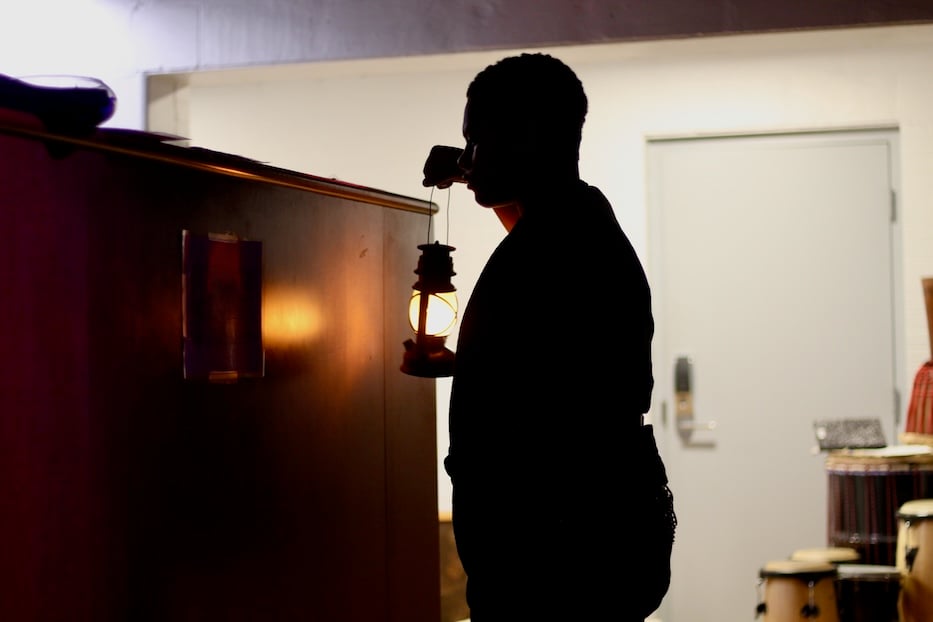
Ghosts ghosts ghosts: Semaj Battle-Reed as the Old King up top, and Christopher Samuels as the most Zombie-esque Hamlet at the bottom.
The result becomes a surprisingly timely reminder to check in on people and mind one’s own mental health. Onstage, characters face mounting paranoia not just because of ghosts, but because they aren’t taking the time to communicate, to figure out what they and others need, to literally double check that they aren’t stabbing the wrong person (sorry, Polonia). Offstage, some actors said, that has meant that they do take a minute to reset, especially amidst the stress of high school and a world on fire.
Half an hour before Monday’s rehearsal, a quartet of cast members flopped down on the couch in a makeshift green room, hair and makeup already in place. For a moment, it was hard to remember that this was a high school, and not the staging area for a rock concert or reunion tour. Thanks to costume design from Quintanilla, they looked as if they could be a band, ready for a photo shoot.
As vocal warmups started outside the room, all of them said that the roles have helped them put mental health and high school in perspective, from trying on different voices and moods to making sure they are taking time for themselves. That’s especially meaningful this year, as the freshmen Scurry started with in the fall of 2022 prepare to graduate in June of next year.
“I think in high school, there’s kind of a perspective of like, ‘Well of course you’re gonna be depressed, you’re in high school.’ Of course you’re gonna be overwhelmed, you’re in high school. Of course you’re gonna have all of these feelings and have all of these things, you’re dealing with life,” said Engel-Halfkenny. “And it’s like, yeah! We are going through these things. And also, how do we make this better?”
“Yes, I’m drained!” chimed in Quintanilla, who had arrived early to do hair and makeup and make sure her characters were ready. This year, she’s struggled to stay on top of a heavier workload, a full rehearsal schedule, and a need to balance her roles onstage with her jobs in the crew, part of a stretched drama program in which everyone wears multiple hats. “I’ve never been drained like this before.”
What she’s learned though, is to pause and make sure her friends are getting what they need—and she is too. When she’s feeling overwhelmed, she tries to think about how quickly Hamlet’s mental health spiraled out of control.
“There is a way for teenagers to be teenagers and not be ridiculously depressed,” Engel-Halfkenny said. “I hope that this storyline can help people understand that.”

